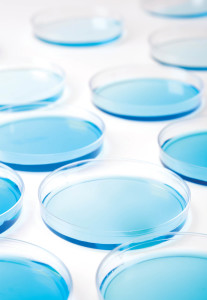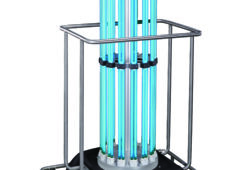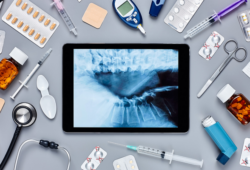In the two decades since Dr. Kary Banks Mullis received a Nobel Prize in chemistry for his work on the polymerase chain reaction (PCR) technique, the use of DNA in the molecular analysis of microbes has moved from high-level research facilities into the hospital pathology lab.
At the same time, the field of potential vendors for molecular diagnostic equipment continues to expand, which poses both opportunities and challenges for hospital administrators and supply chain managers.
As often happens, the availability of useful technology threatens to outpace the development of strategies for using it, says Belinda Vanatta, assistant vice president of laboratory services at HealthTrust.
Identifying ‘Superbugs’
Molecular diagnostics gives hospitals the ability to quickly and accurately identify aggressively infectious, treatment-resistant microbes like Methicillin-resistant Staphylococcus aureus (MRSA), Staphylococcus aureus (SA) and Clostridium difficile (C. difficile).
These and other superbugs can spread rapidly among patients, producing difficult-to-treat hospital-acquired (nosocomial) infections that complicate existing conditions, sometimes lethally.
The rising incidence of such infections helped prompt the federal government to issue new Medicare regulations denying payments to hospitals for the additional costs associated with treating patients for certain nosocomial infections.
Traditional methods of identifying infectious microbes involved culturing specimens and testing their reaction (or lack thereof) to specific antibiotics. These can take a day or more, but DNA assays can do the job in two hours or less, Vanatta says.
Speed is critical when dealing with such infections. Patients who come into a healthcare facility with them must be isolated and special precautions taken to avoid infecting other patients.
“Hospital administrators need to be aware that this technology is available, but also that they need to develop a strategy about how to use it.”
Understandably, it’s tempting to set a policy of testing all incoming patients. But testing all new admissions for MRSA, for instance, would consume virtually all of a hospital’s testing budget, because DNA assays are expensive, Vanatta says.
“Hospital administrators need to be aware that this technology is available, but also that they need to develop a strategy about how to use it,” she says.

One step toward developing a strategy would be for hospital management to analyze their typical patient population. For example, hospitals that admit a lot of patients from long-term group facilities, e.g., nursing homes, etc., probably should screen those patients for MRSA, because it tends to be more common in such settings, she says.
This way, instead of isolating all patients, the hospital can check potentially at-risk admissions and immune-compromised patients and know within a couple of hours if a new patient is infected.
Another consideration in setting strategy is to make wise purchasing decisions. Many analyzer devices currently available test for only one kind of organism or gene deletion. When testing for multiple assays is desired, staff must be trained on protocols, processes and maintenance for each “box,” Vanatta says.
Rapid obsolescence is also an issue. The market is fragmented into many competing vendors, and it’s not clear what form consolidation will take or which ones will remain viable, she says.
HealthTrust members and the Laboratory Advisory Board have made it clear that they want devices and instruments that can perform multiple assays, and contracted vendors such as BD and Cepheid are responding with new additions to their current testing platforms, she says.
From Petri Dish to Genes
The era of molecular diagnostics dawned in the early 1990s with the groundbreaking work of Dr. Mullis on developing the PCR technique. PCR is a method for copying and synthesizing large amounts of DNA, starting from a sample too small to detect.
Molecular diagnostics uses PCR or similar processes as a stepping stone to rapidly identify organisms that used to take much longer to analyze or that required a much larger sample.
The traditional way of testing for bacteria involved collecting and culturing a sample in a dish, then testing its reaction to various antibiotics or other drugs. This could take up to 72 hours to determine the cause of an infection—not an acceptable timeframe when dealing with potential superbugs. Samples also needed to be very fresh.
While awaiting results, physicians often prescribed broad-spectrum, and many times less-than-optimal, antimicrobial drugs to try to control the infection. The ongoing infection presented a risk to other patients, and the use of untargeted treatments tended to reinforce the bacterium’s resistance.
“Molecular diagnostics bypasses the growth issue altogether and instead looks directly at the DNA for identification,” Vanatta says.
Is Genome Sequencing Next?
While the focus now is on molecular diagnostic assays to detect and halt the spread of hospital-acquired infections, the future will bring even more powerful diagnostic tools into the hospital lab.
At the Association for Molecular Pathology’s 2012 conference, Vanatta heard presentations on bench-top devices that can sequence entire genomes in a few hours, with costs falling toward the $1,000 mark. By comparison, the sequencing of the first human genome, which was completed in 2000, took several years and millions of dollars.
This kind of technology already is being applied to improve diagnosis and treatment of cancers, by identifying biomarkers that may cause a tumor to be susceptible to specific drugs.
For example, at the conference, researchers reported they had analyzed a woman’s breast cancer tumor that had resisted conventional treatment, and found a gene that is present in colon cancer. They tried treating her with a medication used for colon cancer, and she responded to the treatment.
“That diagnostic ability will start becoming widely available to hospitals soon. Supply chain managers can expect their physicians will start asking for it, so they need to be thinking about a strategy for the technology,” she says.
Referral to a reference laboratory is an alternative to in-house testing. The referral may cause a decrease in result time, but the tradeoff of not having to purchase equipment may be clinically and financially preferable.
Share Email Hospital Acquired Infections, Molecular Diagnostics, Patient Care





